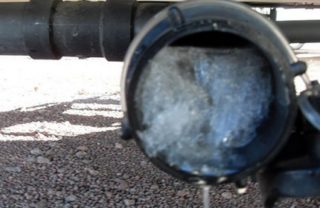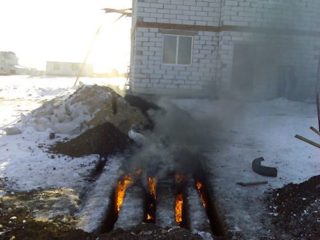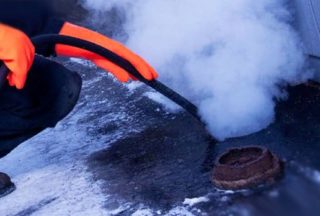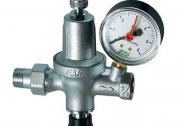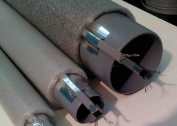If the rules for laying the water supply in private possessions are not observed, the highway freezes in frosts. The water supply to the house is interrupted until the problem is resolved. It is necessary to carry out the heating of the water supply system underground extremely carefully, so as not to provoke a sharp temperature drop, otherwise the pipe will simply break.
How to determine the freezing point
If the highway is frozen underground, before starting the heating of the line you need to find an ice plug. To do this, experts recommend the following:
- In accordance with the plan for laying communication, it is worth evaluating the state of the soil on the surface. The most visually frozen areas are potentially dangerous. Especially if there are corners in such places of the system.
- Open taps in all plumbing points of the house, basement, pool and track where the water flows and where not. Thus, by the method of exclusion, it is possible to identify a frozen stretch of water supply.
- Remove the initial parts of the communication and use the cable to find the area of the ice jam. Move the rope carefully. If the pipes are polymer, it is advisable to put on a rubberized tip on a metal cable so as not to scratch the internal surface of the system. As soon as the rope rests in a congestion, it is necessary to make a mark on it. An elongated piece of cable is measured from the mark to the end. Thus, we have an approximate distance from the location of the master to the proposed freezing point.
To defrost pipes with water underground, you must act as carefully as possible. Otherwise, they may not stand and burst. Especially carefully you need to be with plastic pipes and PVC.
Necessary tools and materials
To complete the required amount of work, the master prepares a list of required materials and tools. They are selected depending on the method that will be used to warm up the water supply system. More often masters need the following:
- building hair dryer or gas burner;
- a bucket of hot water (barrel;
- cable;
- salt;
- Esmarch's irrigator;
- firewood and paper;
- shovel;
- power cable.
The list of tools and materials may increase / decrease / vary depending on the location of the ice cork location.
The main methods of heating pipes with water underground
Polyethylene pipes for water are able to withstand freezing, so they are so popular when laying the street (outdoor) part of the water supply. Nevertheless, the water in them is able to turn into ice at hefty freezing temperatures, especially if there is no high-quality insulation on the line. To overcome the problem, you can defrost communication. It will take enough time, but if the master acts carefully, the material of the HDPE pipes will remain intact.
Bonfire
The easiest method of heating a water pipe in the ground. It is good if the owner of the house has identified an ice formation zone. In this case, you can try to remove the topsoil with a crowbar and shovel. Firewood is placed at the supposed point of ice and a fire is made. Burn a fire for at least 2 hours. This should be done during the day in order to have, although weak, but support for the winter sun. Smoldering embers can be covered with slate sheets to maximize heat retention. A fire burning before this should warm up the soil and the pipeline.
Hot water
This method works if the water has frozen at the exit of the well. The hot water used gradually helps well. A rag is wound on a frozen section of the line and they begin to water it.First, the temperature of the liquid should be up to 15 degrees. With every third liter, it is gradually increased, bringing it to 70 degrees. Gradually, the ice in the pipe will thaw and open access to running water.
It is strictly forbidden to pour boiling water directly onto a frozen highway. This guarantees an instant rush.
Using hot water and a pump
 A hose, a large barrel and a household pump will come in handy. Defrosting is carried out according to this scheme:
A hose, a large barrel and a household pump will come in handy. Defrosting is carried out according to this scheme:
- Hot water is poured into a large tank and its temperature is kept constant. You can use a large boiler, a blowtorch, a bonfire, a pressure cooker, or a simple kettle, which is diluted under the tank, for this.
- Take a hose, the cross section of which should be less than the diameter of the water pipe, and enter into the highway from the source of the water supply. The flexible tube should rest against a cork of ice.
- The second end is put on the pump and lowered into a barrel. The crane in the house must be open.
- When the equipment is turned on, the unit will supply hot water to the pipeline. Together with it, it is necessary to push the cable deeper, as the ice unfreezes.
- From time to time it is necessary to turn off the unit and allow water to drain through the existing hole in the pipe.
When the cork is completely defrosted, water drains from the tap. After that, you can reassemble the water supply node at the source.
Brine
Rapa is used to neutralize ice in pipes. To do this, prepare a strong solution. Water with salt is mixed in a proportion of 3 tablespoons per 1 liter of water. It is desirable that the liquid is at room temperature.
To complete the work you will need:
- Esmarch's irrigator;
- water level;
- steel hardened wire.
You need to do the following:
- The hydraulic level tube and the steel wire are connected in length. At the end, a bend can be made to provide greater rigidity to the flexible structure. In this case, the edge of the hose should protrude slightly beyond the bend of the wire.
- The second end of the tube is joined with Esmarch's mug.
- The hose is gradually introduced into the plastic / polypropylene / metal water supply system until it stops in a cork.
- Esmarch's mug is filled with brine and raised up. The brine flows into the line and gradually defrosts / corrodes the ice. Water must be constantly added to the enema.
It is advisable to place a bucket under the tap into which melt water will flow. During work, the system must be kept open. As soon as the freezing point is overcome, water will flow by gravity.
Steam generator application
In this case, the sequence of actions will be as follows:
- Water is poured into the reservoir of the steam generator and a hose with a small cross section (smaller than the diameter of the water pipe) is connected to it.
- The second end of the flexible tube is inserted into the line until it stops.
- Under the open tap of the system, they put a bucket to collect melt water, which will drain when steam begins to act on the ice.
- The steam generator is turned on and hot air is introduced into the tube.
Complete defrosting of the cork with a thickness of 10 cm takes up to 5-10 minutes. Pause periodically so that the inner wall of the communication can withstand the generated voltage.
If you don’t feel like messing around with the system in this way, you can dig out the frozen section of the line and heat it with a hair dryer or a welding machine.
Preventative measures
To prevent freezing of water pipes in winter, a number of preventive measures should be taken:
- When laying communication, it is worthwhile to first know the level of soil freezing in the region. The line must be mounted lower so that the pipes do not burst from ice plugs.
- If this is impossible or time-consuming (for example, for the northern regions, the level of soil freezing is from 1.5 to 2.5 meters or more), you need to qualitatively warm the system. For this, various materials are used from an electric cable to special polystyrene, mineral wool cylinders.
- If the house is not used for the winter period, it is advisable to completely drain the liquid from the system.
- Often on the purchased site communications are already laid. It is worth asking the previous owners at what level the line is mounted. Dig a section of the highway, check the reliability of the laying and insulation of the pipes. While the spring / summer street, you can fix the exciting moments.
- Be sure to give due attention to the areas at the outlet of the water supply from the source and its entry into the house. They are differential, which means that they constantly collect condensate, which in the future will cause the formation of icing.
Reliable insulation of communications will avoid serious emergency work. The line will not freeze and cause trouble.
